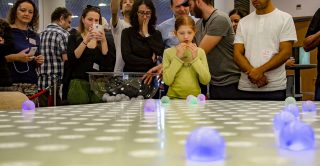Gridi is a large scale tangible MIDI sequencer (2.80 X 1.65 Meters) with embedded LEDs.
It was created by music producer Yuval Gerstein with the goal of letting users create a musical composition in an accessible and intuitive way.
The idea is simply to allow people with little to no background in music to compose an original track, by placing transparent balls inside the interface. The balls light up and when the beat reaches the ball it plays its sound. The user can easily create a drum track, a bass line, and then a melody on top as well.
“Gridi translates the methodology of composing electronic music inside a computer software, into an interactive physical installation,” explains Gerstein.
How It Works
 GRIDI has 16X16 grid of holes inside it. Each hole has an LED and a button behind it. The LEDs are programmed to light up according to the tempo of the track.
GRIDI has 16X16 grid of holes inside it. Each hole has an LED and a button behind it. The LEDs are programmed to light up according to the tempo of the track.
Each column lights up in its own time and represents the cursor moving from left to right in 16th notes, as in a music software. When a ball is placed in one of the holes, the LED changes its color to show an input was received. Once the beat reaches the ball, it makes a sound.
The user can compose music by placing the balls anywhere on the grid. The administrator can make effects and tempo changes by using touchable software controlling Ableton Live from an iPad.
The ball presses a momentary button placed below the LED (A button similar to the one found in a computer mouse), the button transmits a signal to an Arduino, which tells it a button was pressed. The LED under the ball lights up.
At the same time the signal reaches the computer and tells it to write a MIDI note in that particular place in the grid. When the beat reaches the ball, a sound will come from Ableton’s sequencer, which was preprogrammed to make a certain sound.
The sketch on the Arduino communicates with a Max For Live plug-in, which makes it all work together.
Physically, GRIDI is made out of four wooden plates (MDF), colored in white and placed together on a metal base. A CNC machine cut out the plates. Under the hood, each hole has one LED and one button. The LEDs are pre wired and connected in a sort of “snake” fashion. Each button is individually wired to ground and to the PCB board which acts as the brain of each plate. The wiring was the most difficult and time-consuming job (lesson for the future). One Arduino Uno unit enables the entire communication of the project.
Details on the project are available at Gerstein’s site.
Is This The World’s Largest MIDI Sequencer?
Is this the world’s largest MIDI sequencer? It may depend on what you consider a MIDI sequencer. NIN, for example, used a stage-wide grid controller for programming beats on a recent tour.
Let us know if you’ve got other examples to consider in the comments!
via hackaday

bille jean?
how about thriller?
the crowd could get in the act
not sure if it had midi but what about the walk on keyboard from “Big”?
there was a band which had a bunch of women from San Francisco (I believe, it was on Cnet) that tossed out these large balloon balls that had midi contacts on them that triggered samples when the audience smack them
Love this idea.
Back in mid May we some we Yuvi about GRIDI (in fact he contacted us in October 2015), but in May he spoke primarily about the Billie Jean project, which is pretty interesting: https://ask.audio/articles/watch-gridi-worlds-largest-midi-sequencer-performing-michael-jacksons-billie-jean
Hey, this new website design sucks. Change it, please 🙂
i actually like it.
allot more stable and no more multi audio sounds
I have a friend that programmed a MIDI sequencer into an old PDP 11/70 mainframe.
It is pretty badass….google the front panel of one, even looks the part.
That girl in the picture looks amazed.